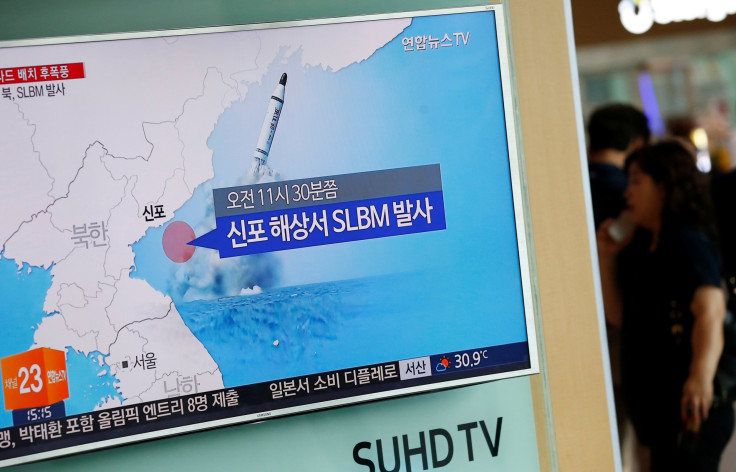War On Korean Peninsula? North Korea Says Missile Drill Was To Practice Striking South Korean Ports

North Korea said Wednesday that the three ballistic missiles it fired early Tuesday were part of a target practice for potential preventive strikes against South Korean ports and airfields. The missiles, which were fired into the sea off the North’s east coast, were considered to be the latest move by the reclusive nation to boast its military might.
According to South Korean Yonhap news agency, Pyongyang test-fired the ballistic missiles in an apparent “armed protest” against the joint decision by the U.S. and Seoul to deploy Terminal High Altitude Area Defense (THAAD) system, an advanced anti-missile system, in the Korean Peninsula to counter potential North Korean missile and nuclear threats.
“The drill was conducted by limiting the firing range under the simulated conditions of making preemptive strikes at ports and airfields in the operational theater in south Korea where the U.S. imperialists’ nuclear war hardware is to be hurled,” North Korea said in a statement, carried by the Korean Central News Agency (KCNA).
KCNA also reported that the North Korean leader Kim Jong Un “provided field guidance to the drill” that took place in Hwangju in the country’s North Hwanghae province. Rodong Sinmun, the North’s main newspaper, also ran eight photos related to Tuesday’s missile launches on its front page, with one showing a smiling Kim satisfied with the tests and others showing the three missiles being launched.
The projectiles, identified as two Scud missiles and one Rodong, a home-grown missile based on Soviet-era Scud technology, were launched days after Pyongyang said it would answer the deployment of the THAAD missile defense system with a “physical response.”
Although the Scud missile has a maximum range of 430 miles while the Rodong missile is capable of traveling up to 800 miles, North Korea reportedly tested the missile within a limited range.
The South Korean military said Tuesday that the ballistic missiles flight went from 500 kilometers (300 miles) to 600 kilometers (360 miles), far enough to strike all of South Korea, including the southern port city of Busan.
“In addition to the basic goal of enhancing missile units' readiness to fight, it might be a way of reminding their southern neighbors that the site chosen for a THAAD battery in South Korea is within reach,” Joshua Pollack, editor of the U.S.-based Nonproliferation Review, told Reuters.

The Korean People's Army (KPA) said in a statement that the U.S. military forces in South Korea will be the first targets of any attack, followed by South Korean “puppet” troops.
Meanwhile, both the U.S. and South Korean military have clarified that in the event of war in the Korean peninsula, reinforcements would be supplied from the U.S. mainland as well as from Japan.
Following Tuesday’s missile launches, the U.S. also pledged to strengthen sanctions on the “leadership of North Korea.” According to the U.S., Pyongyang has raised the concerns of the international community, requiring more pressure on the country’s government to suspend all activities related to its ballistic missile program.
“We're always looking at ways we can continue to apply pressure and what we talked about frankly is the sanctions are pretty severe right now. What matters is how we enforce those sanctions and that actually involves better coordination among all the countries in the region and that includes China,” Mark Toner, a spokesman for the U.S. State Department, told The Korea Times.
© Copyright IBTimes 2024. All rights reserved.






















